The Scandinavian folk clothing right for now
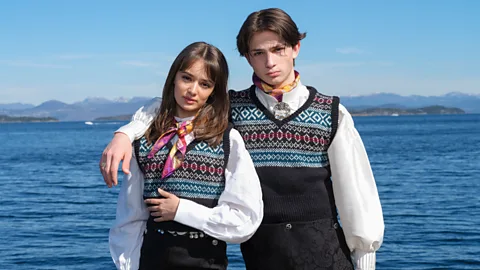 Embla Bunader
Embla BunaderHow do you respect tradition while also making sure you feel like yourself? Matilda Welin explores how re-invented, non-binary national dress is gaining popularity with a new generation.
What is your most precious piece of clothing? Mine is a traditional folk dress from my home country, Sweden. It was hand-made by my grandmother, who gave it to me a few years before she passed away. The dress – or, should I say, ensemble, as it also encompasses hat, shoes, an apron and even a removable pocket – comes from the province where she was born, the neighbouring one to my own. It is striped blue and purple, and has a green bodice with red trimming. A tin brooch holds the scarf in place. Old family photos show Gran and her three older sisters in identical dresses outside a hembygdsgård (cultural centre), and my father and grandmother in his-and-hers costumes against a backdrop of a bright Swedish summer. The musical and folk heritage of my family is passed down in my dress. There's only one problem. I don't wear dresses. How do you respect tradition while also making sure you feel like yourself?
More like this:
National costumes have existed in Scandinavia for centuries. Originating from everyday peasant clothing, they were elevated to formalwear during the national romanticism era of the early 1900s, and strict rules for colours, cuts and fabrics were prescribed. Since then, even wearing a dress from a different region than your own can be seen as a breach of tradition. But now, Scandi folk clothing is evolving. More and more people are amending their costumes to fit modern times. Tiril Skaar, from Norway, is one of them.
Skaar, who is non-binary and transmasculine, and uses they and them pronouns, bought their women's bunad – as the Norwegian call their traditional costume – for their teenage Church confirmation ceremony, thinking it could be passed down to future children. But over time, they felt less and less comfortable in such a traditionally female outfit. Increasingly, the beautiful, detailed bunad was left in their wardrobe, unworn. "If you would have asked me then, I would have said I didn't dare [to break the norms]", Skaar tells BBC Culture. "I asked the people I studied with, 'What would you think about a gender-neutral bunad?'. Some were hesitant. I was afraid." Some traditionalists are protective of folk dress customs, and can be very particular about the bunad rules and codes – Skaar refers to them as the "bunad police".
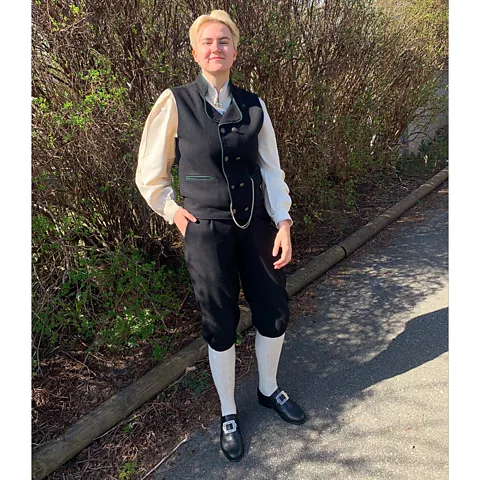 Courtesy of Tiril Skaar
Courtesy of Tiril SkaarDuring the pandemic, Skaar pondered the situation. "I thought, 'I can make up my own style – that's something I've done my whole life'." After combining the original female shirt with masculine trousers, they re-purposed an original piece of their bunad jewellery into a pocket-watch chain. "From a distance, the outfit looks more masculine – and that is how people see me. Maybe when I'm richer I can add more details. The skirt of my old women's bunad had embroidery of birds and nature. I'd like to move that to my new vest."
At the end of the pandemic, as Norwegians were told to avoid big crowds, Skaar tried out the new bunad in smaller groups. Then, on the Norwegian independence day last year, they wore it out and about. "By then, I wasn't nervous," they explain. "I had already been in interviews and TV shows, and got so much positive feedback. Many people said they felt the same as me. I felt I had a responsibility to be a representation for others."
Marianne Lambersøy is the co-owner of Embla Bunader, which sells bunads and accessories in five shops across Norway. Keen to make traditional garments accessible for everyone, Embla also offers a bunad-matching hijab. A few years ago, the company was approached by a new group of customers looking for non-binary bunad alternatives. Could Embla help?
"It was a difficult design," Lambersøy tells BBC Culture. "I was lying awake many nights. Should I offer shorts to everyone? A skirt to everyone? A skirt that looks like a kilt?" In the end, options were given of either shorts, trousers or a skirt. Lambersøy used damask, a patterned silk fabric, for the legwear, "because everyone who knows bunad knows that is high quality" and kalemank, a woven wool, for the jacket, because it is a traditional bunad fabric, originally imported from Norwich via old Norwegian-British trade links. "It's the finest fabric we have in Norway, it oozes quality", she says. There is also a knitted vest in black, with patterns in the colours of the Norwegian flag: white, blue and red.
 Elisabeth Jubelin Ellieganza
Elisabeth Jubelin EllieganzaThe interest for the new bunad was high. But one thing surprised Lambersøy. "I thought people would get creative with the different choices," she says. "But no. They want it the way it is supposed to be. They want to follow the rules."
Perhaps that is not so surprising. Ever since 1847, the Norwegian Institute for Bunad and Folk Costume (which started out as a government department) has categorised and catalogued most regional bunad in Norway. Lambersøy even warns customers who ask her to change up their usual costume, be it in a gender-conformist way or not, that this can provoke negative reactions. But personally, she thinks mixing accessories, like removing an apron or adding a silk scarf, only leads to a greater cultural wealth. When the non-binary bunad was finished, the Norwegian Institute for Bunad and Folk Costume in the end supported the innovation.
A new folk tradition
In 2018, at the same time as Tiril Kaar was mulling over the style of their Norwegian folk dress, Swedish artist Fredy Clue was thinking about culottes. Clue, who also uses they and them pronouns, was searching for their own space in the Swedish folk culture. Eventually, as the trouser skirt became the basis for the design of a non-binary Swedish folk dress, they realised that they, too, were non-binary. "My inner self spoke through my ideas," Clue tells BBC Culture.
Clue developed the Bäckadräkten unisex folk dress with the help of artist Ida Björs. The two studied historical clothes designs, travelled to the folk-culture-rich province of Hälsingland, and ran a focus group with five young, non-binary people.
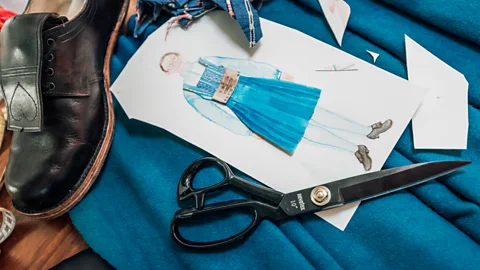 Elisabeth Jubelin Ellieganza
Elisabeth Jubelin Ellieganza"Ida is from Hälsingland, so many things in my outfit like the belt and the shoes are from there," Clue says. "I live in Gothenburg, and I sail a lot, so we have also incorporated port and starboard symbols as jewellery, and the shoe heel is inspired by a boat. The theme of water flows through the suit, too. The brook, or beck, represents our life force, which flows and changes every day, even though we are still the same water."
The costume's hat is a so-called wedge hat, normally used by boys and men. But during their research, Clue and Björs found one place in western Sweden where it was worn by women. "The hat is the queerest part of the suit," Clue says. "We are lucky to have fabric from a groom's waistcoat from the town of Ljusdal that just happens to have the same colours as the trans pride flag. We use wool and linen. This stuff is old, it is all within the folk-dress niche. It's just fun to make it more alive."
The Swedish version of the bunad police is the dräpo, a moniker derived from the words "dress police" which also rhymes with the abbreviation for the national intelligence bureau, Säpo. This group doesn't daunt Clue. "I got into folk culture a little bit sideways," they say. "Maybe that helped me to be less afraid to break the rules." The project has also caused discussions on social media. "Many people feel threatened, they feel that men and women are being blurred," Clue says.
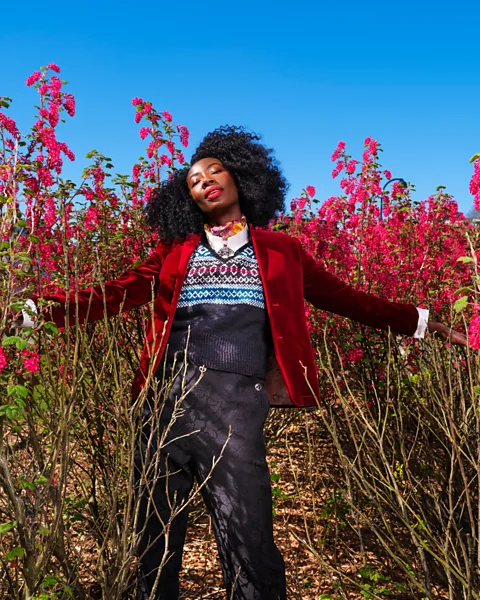 Embla Bunader
Embla BunaderBut what about too much change? What if the rules are relaxed so much that Scandi folk suits end up being just a pair of jeans and a T-shirt? None of the people BBC Culture speaks to are worried. "You can't sew exactly like your gran," Clue points out, "so even if you made a new dress in the same style as hers for yourself, that would still be a new expression." Change is inevitable. "The latest traditional costume was created in the 1960s or something. I want my costume to look like a folk costume, but I am one of the ranks of folk dress users, representing this century and this identity," they add. "I am also one of the folks within the folk tradition."
In northern Scandinavia, the traditional home of the indigenous Sami people, folk clothing differs from what is found in the south. Sami people tend to wear their traditional dress, including the pullover or smock known as the gákti, for everyday occasions more often, and it also symbolises indigenous pride and resistance. The notion that colonisation often imposed a Western binary view of gender on indigenous societies adds yet another level to the issue.
Over the past decade, the discussions about the development of queer or non-binary gákti has become increasingly prevalent, both in Sweden and in Norway, with discussions on social media and in radio and newspapers.
Ultimately, it feels like the changes happening in Scandinavian traditional clothing in order to accommodate its wearers are enriching the folk custom, and allowing it to be shared by more people. Talking to Fredy Clue and the others, I feel inspired. Maybe I, too, can wear my grandmother's northern Swedish dress in a way that suits me.
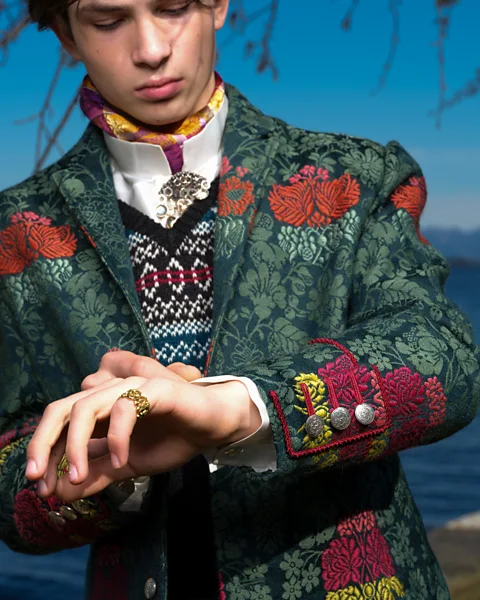 Embla Bunader
Embla Bunader"To keep the traditions, we must keep them up to date with the world," Tiril Skaar says. "And I am true to the tradition. My shirt is not just any old shirt, and I kept the silver. You can keep that and change the gender expression. That way we are true to our heritage and also true to ourselves. If we don't do that... Well, I had the women's bunad for so many years in the closet. But I want to wear my bunad. I don't want to hide."
In the future, Skaar believes, more people will be brave enough to wear their traditional costumes their own way. "There is that saying," they add. "You can't be what you can't see."
And if you liked this story, sign up for the weekly bbc.com features newsletter, called The Essential List. A handpicked selection of stories from BBC Future, Culture, Worklife and Travel, delivered to your inbox every Friday.
